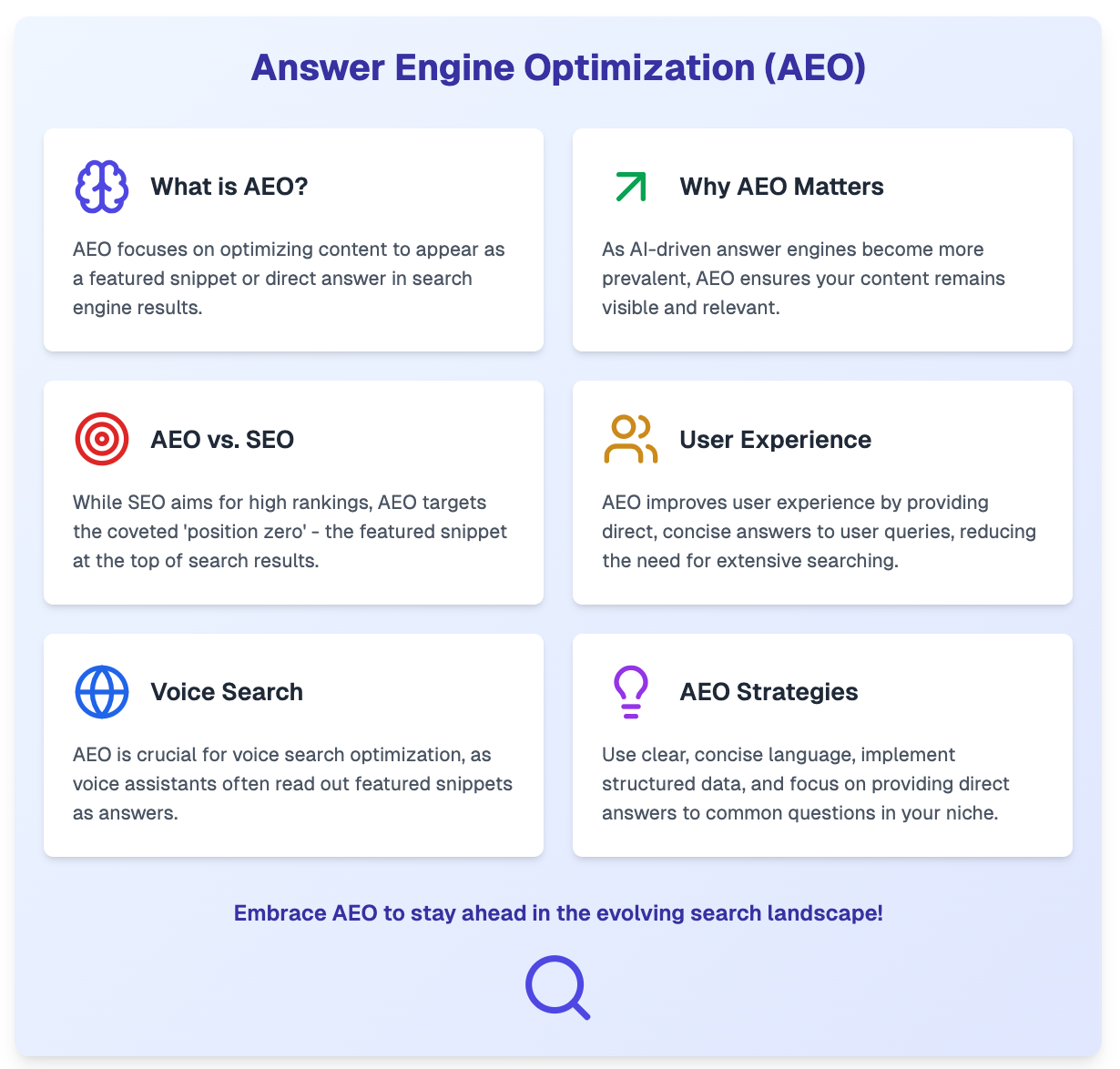Answer Engine Optimization: The Next Evolution of SEO
In the rapidly evolving landscape of digital marketing, a new paradigm is emerging: Answer Engine Optimization (AEO). This concept, recently highlighted in a conversation between Perplexity CEO Aravind Srinivas and Lex Fridman[1], represents a significant shift in how we approach online visibility and content strategy.
What is Answer Engine Optimization?
Answer Engine Optimization is the practice of optimizing content to appear in AI-powered answer engines and large language models (LLMs). Unlike traditional Search Engine Optimization (SEO), which focuses on ranking in search engine results pages (SERPs), AEO aims to make content more likely to be cited or referenced by AI systems when answering user queries.
Why AEO Matters
As AI-driven answer engines like Perplexity AI and ChatGPT gain popularity, they're changing how users seek information. Instead of sifting through multiple search results, users increasingly expect direct, comprehensive answers. This shift necessitates a new approach to content creation and optimization.
Key Differences Between SEO and AEO
- Content Depth: While SEO often emphasizes keyword density and meta-data, AEO requires in-depth, authoritative content that AI can draw upon to formulate comprehensive answers.
- Context and Relationships: AEO focuses on establishing clear relationships between concepts and providing context, helping AI systems understand and synthesize information more effectively.
- Structured Data: While important for both SEO and AEO, structured data becomes even more crucial in helping AI systems interpret and utilize information accurately.
- Citation Optimization: AEO involves optimizing content to be easily citeable by AI systems, potentially including clear attributions and easily parsable formats.
Strategies for Answer Engine Optimization
- Create Comprehensive, Authoritative Content: Develop in-depth articles that cover topics thoroughly, providing clear explanations and context.
- Use Clear, Structured Formats: Organize information logically with headers, lists, and tables to make it easily digestible for both humans and AI.
- Implement Robust Schema Markup: Use schema.org vocabulary to provide clear, machine-readable context about your content.
- Focus on E-E-A-T: Emphasize Experience, Expertise, Authoritativeness, and Trustworthiness in your content to increase the likelihood of AI systems referencing it.
- Optimize for Natural Language: Structure content to answer specific questions, mirroring how users might phrase queries to an AI assistant.
The Future of Digital Visibility
As Srinivas pointed out in his conversation with Fridman, the rise of answer engines represents a fundamental shift in how information is accessed and presented online. Businesses and content creators who adapt to this new paradigm by implementing AEO strategies will be better positioned to maintain visibility and relevance in an AI-driven information landscape.
While traditional SEO remains important, forward-thinking digital marketers are already incorporating AEO principles into their strategies. As AI continues to advance, the ability to optimize for these systems will likely become an essential skill in the digital marketing toolkit.
By embracing Answer Engine Optimization, we're not just adapting to a new technology – we're participating in shaping the future of information discovery and dissemination in the digital age.

Conclusion
Answer Engine Optimization represents the next frontier in digital marketing and content strategy. As AI-powered search and answer engines continue to grow in prominence, adapting our approach to content creation and optimization is crucial. By focusing on comprehensive, well-structured, and authoritative content, we can ensure our digital presence remains strong in this new era of information retrieval.
References
- Fridman, L. (2024). Aravind Srinivas: Perplexity AI and the Future of Search. YouTube